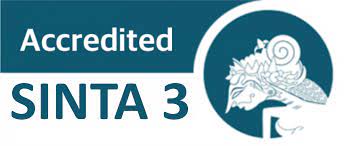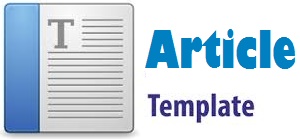Author Guidelines
General Organization of Paper
Abjadia: International Journal of Education welcomes high-quality research submissions in education. These guidelines are designed to assist authors in preparing and submitting their manuscripts for consideration. By adhering to these guidelines, authors can ensure a smooth submission and peer review process.
General Terms of Manuscripts:
- Language: Articles must be written in English or Arabic. Especially for Abstracts and Keywords must be in English. Articles in other languages will be rejected and returned to the author.
- Formatting: Prepare your manuscript in Microsoft Word using a standard font (Book Antiqua for English and Sakkal Majalla for Arabic ).
- Title Paper: Include the title, author's name, affiliations, and contact details (email and phone).
- Abstract: Provide a concise abstract of around 150-250 words summarizing the research objectives, methodology, key findings, and implications.
- Keywords: Include 3-5 relevant keywords to aid indexing and discoverability.
- Primary Text: Organize your manuscript into clear sections, such as Introduction, Literature Review, Methodology, Results, Discussion, Conclusion, and References.
- Citations and References: Use APA style for in-text citations and the reference list. Ensure accurate and complete sources.
- Article Template: to make it easier for writers, please download the Article Template for the Abjadia Journal.
- Document Format: Manuscript documents submitted to the journal Abjadia must be written in Microsoft Word format (.docx). Manuscripts in PDF or other format will be rejected and returned immediately
Additional Explanation:
Title Paper
This is your opportunity to attract the reader's attention. Remember that readers are the potential authors who will cite your article. Identify the central issue of the paper. Begin with the subject of the paper. The title should be accurate, unambiguous, specific, and complete. Do not contain infrequently-used abbreviations.
The paper's title should be less than 20 words, for articles in Arabic must be written with two titles (English and Arabic). Article in English enough with 1 English title. Should Have English Title and Roman script.
- 14pt Book Antiqua, Bold, UPPERCASE, 1.15 (space lines) for English
- 18pt Sakkal Majalla, Bold, 1.0 (space lines) for Arabic
Author's Name and Affiliations
Write Author(s) names without titles and professional positions such as Prof, Dr, Production Manager, etc. Affiliation includes the name of the university and country. Please indicate the Corresponding Author (include email address) by adding an asterisk (*) in superscript behind the name.
Author names should be in 1q pt Book Antiqua Bold. The author's addresses are superscripted by numerals and centered over both columns of manuscripts. Author affiliations should be in 10 pt Book Antiqua.
Abstract and Keywords
An abstract should stand alone, meaning there is no citation in the Abstract. Consider it the advertisement of your article. The Abstract should tell the prospective reader what you did and highlight the key findings. Avoid using technical jargon and uncommon abbreviations. You must be accurate, brief, clear, and specific. Use words that reflect the precise meaning. The Abstract should be straightforward and honest. Please follow word limitations (150‐250 words).
Keywords are the labels of your manuscript and are critical to correct indexing and searching. Therefore the keywords should represent the content and highlight your article. Use only those abbreviations that are firmly established in the field. A semicolon should separate each word/phrase in the keyword (;).
Body Text
The body of the text is a set of body text paragraphs defined as follows:
- 12pt Book Antiqua, 1.15 (space lines), Spacing (Before 6pt, After 6pt) for English
- 16pt Sakkal Majalla, 1.15 (space lines), Spacing (Before 6pt, After 6pt) for Arabic
Tables
Tables are sequentially numbered with the table title and number above the table. Tables should be centered in the column or on the page. Elements of a table should be single-spaced. However, double spacing can show data groupings or separate parts within the table. Table headings' font Calibri or Sakkal Majalla, 9pt. Tables are referred to in the text by the table number, e.g., Table 1.
Figures
Figures are sequentially numbered, commencing at 1 with the figure title and number below the figure, as shown in Figure 1. Detailed recommendations for figures are as follows:
- Ensure that figures are clear and legible with typed letterings.
- Black & white or colored figures are allowed.
- A figure spanning two columns should be placed at the top or bottom of a page.
- If figures cannot be scanned, the original should be placed in its location within the manuscript using wax or colorless glue.
- The following files are permissible:
- Microsoft Graph
- Microsoft Draw
Manuscript Heading, Font, and Spacing
The manuscript should be typed using word processors (Microsoft Word or Open Office) software. The font used throughout the paper is Book Antiqua (English) or Sakkal Majall (Arabic). The paper size is A4. The page margins are 2.5 Top, 2.5 Bottom, 2.5 Inside, and 2 Outside. Use Multiple Page: Mirror Margin. To make it easier, download and use the Article Template.
Introduction
In the Introduction, the Authors should state the objectives of the work at the end of the introduction section. Before the objective, the Authors should provide an adequate background and a very short literature survey to record the existing solutions/method, to show which is the best of previous research, to show the main limitation of the previous research, to show what you hope to achieve (to solve the limitation) and to show the scientific merit or novelties of the paper. Avoid a detailed literature survey or a summary of the results. Do not describe the literature survey as author by author, but should be presented as a group per method or topic reviewed, which refers to some literature.
Example of novelty statement or the gap analysis statement at the end of the Introduction section (after the state of the art of previous research survey): "........ (summary of background)....... A few researchers focused on ....... There have been limited studies concerned on ........ Therefore, this research intends to ................. The objectives of this research are .........".
Method
Methods should make readers able to reproduce the experiment. Provide sufficient detail to allow the work to be reproduced. A reference should indicate published methods: only relevant modifications should be described. Do not repeat the details of established methods.
Results and Discussion
Results should be clear and concise. The results should summarize (scientific) findings rather than provide data in great detail. Please highlight differences between your results or findings and the previous publications by other researchers. The discussion should explore the significance of the results of the work, not repeat them. A combined Results and Discussion section is often appropriate. Avoid extensive citations and discussion of published literature.
In discussion, it is the most important section of your article. Here you get the chance to sell your data. Make the discussion correspond to the results, but do not reiterate the results. Often should begin with a summary of the main scientific findings (not experimental results).
The discussion should cover the following components: How do your results relate to the original question or objectives outlined in the Introduction section (what/how)? Do you provide an interpretation scientifically for each of your results or findings presented (why)? Are your results consistent with what other investigators have reported (what else)? Or are there any differences?
Conclusions
Conclusions should answer the objectives of the research. Tells how your work advances the field from the present state of Knowledge. Without clear Conclusions, reviewers and readers will find it difficult to judge the work and whether or not it merits publication in the journal. Do not repeat the Abstract or just list experimental results. Provide a clear scientific justification for your work, and indicate possible applications and extensions. You should also suggest future experiments and/or highlight those underway.
Acknowledgment
Recognize those who helped in the research, especially funding supporters of your research. Include individuals who have assisted you in your study: Advisors, Financial supporters, or other supporters, i.e., proofreaders, Typists, and Suppliers, who may have given materials. Do not acknowledge one of the author's names.
References
The Citation and Reference list uses the APA 6th Style Edition (www.apastyle.org). Please use Reference Manager Applications like EndNote, Mendeley, Zotero, etc. Use other published articles in the same journal as models.
Cite the main scientific publications on which your work is based. Cite only items that you have read. Do not inflate the manuscript with too many references. Avoid excessive self‐citations. Avoid excessive citations of publications from the same region. Check each reference against the source (author's name, volume, issue, year, DOI Number).
All publications cited in the text should be included as references. This journal has to follow standard templates available in key reference management packages Mendeley (https://www.mendeley.com). Using plug-ins to word processing packages, authors only need to select the appropriate journal template when preparing their article, and the list of references and citations to these will be formatted according to the journal style described below.
Book
Lumby, J. (2001). Who cares? The changing health care system. Sydney, Australia: Allen & Unwin.
Book Chapter
McKenzie, H., Boughton, M., Hayes, L., & Forsyth, S. (2008). Explaining the complexities and value of nursing practice and Knowledge. In I. Morley & M. Crouch (Eds.), Knowledge as value: Illumination through critical prisms (pp. 209-224). Amsterdam, Netherlands: Rodopi.
Journal article
Boughton, M., & Halliday, L. (2008). A challenge to the menopause stereotype: Young Australian women's reflections of 'being diagnosed' as menopausal. Health & Social Care in the Community, 16(6), 565-572. http://dx.doi.org/10.1111/j.1365-2524.2008.00777
Webpage with an author
Welch, N. (2000, February 21). Toward an understanding of the determinants of rural health. Retrieved from http://www.ruralhealth.org.au/welch.htm
Webpage with no author
ANCI national competency standards for the registered nurse and the enrolled nurse. (2000). Retrieved from http://www.anci.org.au/competencystandards.htm
Newspaper article
Bagnall, D. (1998, January 27). Private schools: Why they are out in front. The Bulletin, pp. 12-15.
Government publication
The Health Targets and Implementation (Health for All) Committee. (1988). Health for all Australians. Canberra, Australia: Australian Government Publishing Service.
Company and Industry Reports
Magner, L. (2016). IBISWorld industry report OD5381. Coffee shops in Australia. Retrieved from IBIS World database.
Before sending your paper, please perform typographical, grammatical error, and plagiarism by using the:
- Grammarly: www.grammarly.com
- Turnitin: http://turnitin.com
Contact:
- Website : http://ejournal.uin-malang.ac.id/index.php/abjadia
- Email : abjadia@uin-malang.ac.id






